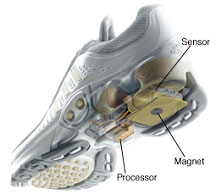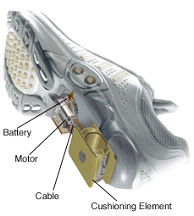Welcher Mode-Trend wird nach den Speed- und Messe-Rollern zu Beginn des neuen Jahrtausends das neue Gesicht einer sportlich bewegten CeBIT prägen? [1]
Vielleicht ist es in Zukunft doch wieder der "Turnschuh", nachdem in diesem Jahr bereits von der Firma Nokia schon der alte "Walkman" in neuer Gestalt als Brand wieder in das Blickfeld der Öffentlichkeit gerückt werden wurde [2]?
Wenn dem wirklich so wäre, dann ist dieser Schuh schon von jener Art, die in Zukunft immer mehr um sich greifen wird: bestückt mit einem Computer, der überhaupt nicht mehr zu sehen sein wird und der dank seines eingebauten Chips erstmals als ein "intelligenter" verkauft werden wird.
Träumst Du? So die Frage auf der
addidas_1
-Flash-Website:
Ein Schuh mit eingebautem Mikroprozessor, der bis zu 5 Millionen Berechnungen pro Sekunde anstellen kann, der Deine Umgebung versteht und sich auf sie einstellt, damit Du jederzeit das richtige Polster unter den Füßen hast.
Unmöglich. Richtig? Falsch! Impossible is Nothing.
Die Idee, mittels Computeranalyse herauszufinden, welcher Schuh für welchen Fuss besonders geeignet ist, besteht schon länger und ist heute mit Methoden wie der dynamischen Druckanalyse mittels eines EMED-Computers gut ausgereift.

Die neueste Meßplatte erlaubt selbst Messungen im Sprintbereich mit exakten Werten. Es werden dabei die Druckwerte des Fußes in Newton pro qcm in jeder einhundertstel Sekunde sowie der Körper-schwerpunkts-verlauf durch den Fuß und die Belastungs-kurve erfaßt.
Daraus lassen sich sehr genaue Rückschlüsse auf das gesamte Bewegungsbild und die Fußstatik ziehen. [3]
Jetzt aber wird der Schuh nicht nur an den Fuss angepasst, sondern an die Grundlage, auf die der Mensch mit diesem Schuh auftritt.
Sollte dieses Produkt wirklich ein Erfolg werden, würde es ja vielleicht mit diesem Projekt auch gelingen, dass in Zukunft selbst Träumer und Visionäre nicht mehr an Bodenhaftung verlören - und so davor wieder besser gefeiht wären, zum Arzt gehen zu müssen.
WS.
Herzogenaurach, Germany, May 10 — adidas has introduced the most advanced shoe ever. Called “1”, the shoe provides intelligent cushioning by automatically and continuously adjusting itself. It does so by sensing the cushioning level, using a sensor and a magnet. It then understands whether the cushioning level is too soft or too firm via a small computer. It adapts with a motor-driven cable system to provide the correct cushioning throughout the run.

It works like a human reflex nerve. The nerve is a magnetic sensing system, where the sensor sits just below the runner’s heel and the magnet is placed at the bottom of the midsole. On each impact, this sensor measures the distance from top to bottom of the midsole (accurate to .1 mm) gauging the compression and therefore the amount of cushioning being used. About 1,000 readings per second are taken and relayed to the shoe’s brain.
Underneath the arch is the shoe’s brain, a microprocessor capable of making five million calculations per second. Software written specifically for the shoe compares the compression messages received from the sensor to a preset zone and understands if the shoe is too soft or too firm.
Once it has determined if the cushioning level is appropriate, it sends a command to the shoe’s muscle to make a change.

A motor-driven cable system is the shoe’s muscle. The motor, housed in the midfoot, receives the brain’s instructions and adapts by turning a screw, which lengthens or shortens a cable. This cable is secured to the walls of a plastic cushioning element. When the cable is shortened, the cushioning element is tensed and compresses very little. When the cable is longer, it allows the cushioning element to compress further, making the shoe’s ride softer. A small battery, which is replaceable and lasts for 100 hours of running (the normal life of a shoe), provides the motor’s power. The changes are gradual and happen automatically, so all the runner notices is that the shoe feels right during an entire run.
Three years in development, the shoe was a secret project, known by only a few people even within adidas. The shoe will be available in March, 2005 and will retail for $250 and 250 Euros.
“This product will change the entire sporting goods industry. It is a true first and establishes adidas as a clear leader in the field of innovation,” said Erich Stamminger, Executive Board Member responsible for Global Marketing and North America. “This is the product that illustrates to us, also when developing products, ‘Impossible is Nothing’."
